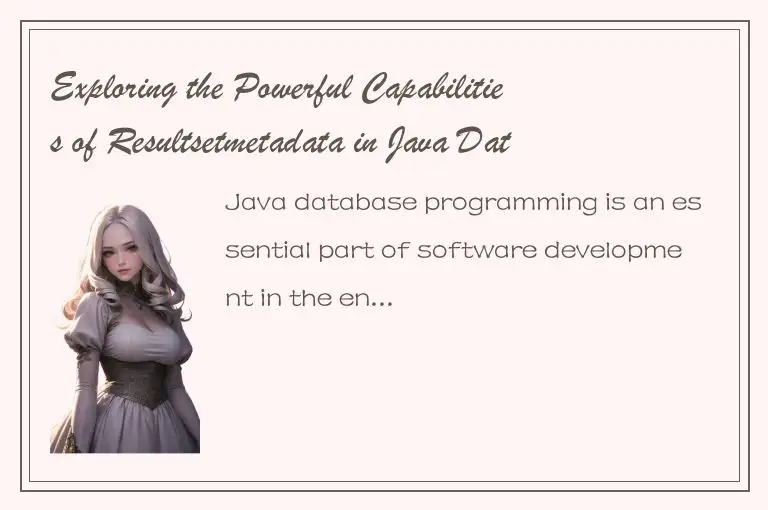Java database programming is an essential part of software development in the enterprise world. Developers must have a good understanding of database concepts, SQL, and JDBC to be able to interact with a database efficiently. One essential part of working with data in Java is the ResultSetMetaData interface. This interface provides invaluable information about the structure and metadata of the result set returned by a JDBC query. In this article, we will explore the powerful capabilities of ResultSetMetaData and learn how to use it effectively.

Understanding ResultSet and ResultSetMetaData
A ResultSet in Java represents a set of data returned by a database query. It provides a means to access and manipulate the data returned by the query. A ResultSetMetaData, on the other hand, is a Java interface that provides information about the structure of the result set.
The ResultSetMetaData interface provides methods to retrieve information such as the number of columns in the result set, the data type of each column, the column name, and the column labels. This information can be used to manipulate and process the data returned by the query.
Using ResultSetMetaData
To use ResultSetMetaData, we need to create a ResultSet first. The following example shows how to create a ResultSet from a database query:
Connection conn = DriverManager.getConnection(url, user, password);
Statement stmt = conn.createStatement();
ResultSet rs = stmt.executeQuery("SELECT * FROM customers");
Once we have a ResultSet, we can obtain a ResultSetMetaData object using the getMetaData() method:
ResultSetMetaData rsmd = rs.getMetaData();
Now we have access to a wealth of information about the result set. Here are some of the most commonly used methods of the ResultSetMetaData interface:
getColumnCount(): Returns the number of columns in the result set.
getColumnName(int column): Returns the name of the specified column.
getColumnType(int column): Returns the SQL type of the specified column.
getColumnLabel(int column): Returns the label of the specified column.
getTableName(int column): Returns the name of the table that the specified column belongs to.
isNullable(int column): Returns whether the specified column allows null values.
getPrecision(int column): Returns the number of digits to the right of the decimal point for decimal types, or the maximum number of characters for character and binary types.
getScale(int column): Returns the number of digits to the right of the decimal point for decimal types.
Using ResultSetMetaData in Practice
Now that we have explored the capabilities of ResultSetMetaData, let's see how we can use it in practice. Here are three examples:
Example 1: Displaying Column Names
One of the most common use cases for ResultSetMetaData is to display column names in a user interface. The following code shows how to retrieve the column names and display them in a console:
int colCount = rsmd.getColumnCount();
for (int i = 1; i <= colCount; i++) {
String colName = rsmd.getColumnName(i);
System.out.print(colName + "\t");
}
System.out.println();
Example 2: Displaying Column Types
Another useful feature of ResultSetMetaData is the ability to retrieve the data type of each column in the result set. The following code shows how to display the column names and data types in a console:
int colCount = rsmd.getColumnCount();
for (int i = 1; i <= colCount; i++) {
String colName = rsmd.getColumnName(i);
String colType = rsmd.getColumnTypeName(i);
System.out.println(colName + " (" + colType + ")");
}
Example 3: Copying Data between Tables
Finally, ResultSetMetaData can be used to copy data between tables. For example, suppose we want to copy all the data from a source table to a destination table with the same schema. We can use ResultSetMetaData to retrieve the column names and data types of the source table, and then create a new table with the same schema. Finally, we can iterate through the result set and insert the data into the destination table.
Conclusion
ResultSetMetaData is an essential interface in Java database programming. It provides invaluable information about the structure and metadata of the result set returned by a JDBC query. We have explored the powerful capabilities of ResultSetMetaData and shown some examples of how to use it effectively. By using ResultSetMetaData, developers can manipulate and process data in Java more efficiently and effectively.




 QQ客服专员
QQ客服专员 电话客服专员
电话客服专员